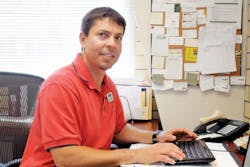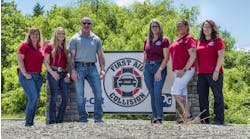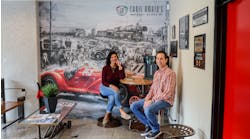When the market for new car sales dropped in 2008, Flow Motors owner Don Flow gathered the managers from his 31 dealerships and service centers into several small groups. The company, based in Winston-Salem, N.C., would have to cut costs across the board in order to save jobs, Flow told his people. Jeff Sapp, manager of Flow Motors Luxury Body Center, was at one of those meetings. The Luxury Body Center, one of three body shops affiliated with Flow Motors of Winston-Salem, had gone from relying on its name and local reputation as a premier luxury collision repair center, to fighting for every sale. Times had changed, and Sapp could see that his body shop, in business since 1989, needed to change, too. That meant one thing: lean.
Sapp was up for the challenge. He thought this was the perfect opportunity to start implementing lean processes into his shop, and he had an idea that he thought just might work to bring in sales for his shop, cut costs for the dealership and streamline operations. Sapp had a proposition for Doug Weaver, general manager of the Flow Motors BMW MINI dealership. He wanted to bring pre-owned cars that the dealership acquired from trade-ins through his shop, which specializes in repairing Acura, Audi, BMW, Infiniti, Lexus, Mercedes, MINI, Subaru, Volvo and VW models. At that time, the dealership had contracted with outside vendors to do the pre-owned repairs. Repairing pre-owns isn’t something most dealer shops—or most shops, period—like to do. But, like so many entrepreneurial-minded people during a recession, Sapp saw opportunity in doing something others might not want to do.
“I saw how much they were spending outside with other vendors and I wanted that money,” Sapp says.
Since January 2009, Sapp’s shop has handled pre-owned repairs for six Flow Motors dealerships, cycling through 30 to 50 pre-owned cars per month. Pre-owned work has gone from nearly nothing to about 15 percent of sales—from $1,500 to more than $9,000 a month. The switch has helped the shop stabilize its sales during a punishing recession. Revenues were $1.7 million last year. Sapp says the shop hopes to do about $2 million this year, closer to its pre-downturn average. But absorbing the pre-owned work previously done by as many as three outside vendors—all experts in pre-owned repairs—wasn’t easy.
“The body shop had to be just as fast, just as good and just as cost effective as our outside vendors,” says Weaver.
Sapp took the challenge. “I recognized I could match what the outside vendors were doing,” he says. “But it was a learning curve for us. Initially the other vendors could turn around a pre-owned car in one to two days, and it was taking us three.”
Sapp knew his shop had to adopt lean principles to compete.
The Pre-Owned Conundrum
Collision centers make their bread and butter on new-car repairs. “The older a car is, the less likely it is to be repaired after a collision,” Sapp points out. Dealerships, on the other hand, make their highest profit margins on used cars. Traditionally, the two worlds have stayed separate. “Body shops are not set up to do reconditioning—the light bumper and wheel repairs,” says Weaver.
Before the downturn, Flow Motors was satisfied with using third-party vendors that specialize in getting damaged pre-owned vehicles back onto car sales lots as quickly as possible. “Turnaround is a little quicker and you have a little more control,” says Bob Smith, pre-owned sales manager for Flow BMW. “When a (pre-owned) car goes to a body shop, a retail customer who has had a collision is typically going to take priority for the shop. So because our vendors focused exclusively on us, they would sometimes be able to pick a pre-owned car up in the morning and have it back to us that afternoon.”
Likewise, body shops traditionally haven’t sought out pre-owned repairs. Because pre-owned fixes involve mainly bumper and plastic repairs and light paint work—not frame or suspension repairs—they don’t typically make enough profit margin for collision shops to be worth the effort. “We don’t necessarily cherish doing pre-owned cars,” says Larry Smith, president of Autometric Collision in Pontiac, Mich., which is not affiliated with any dealerships. Autometric Collision has eight locations and does $20 million in annual revenue. “The dealers want them immediately, in perfect condition, and for next to nothing—three ingredients for a lousy meal. But having said that, in this economy, with used cars being so hot right now, we do whatever they want. When they make a lot of money on their used cars because they look brand new, they love us.”
The Dealer Solution: Go Lean
Having made the decision to start taking pre-owns through his shop, Sapp knew he needed to make changes that would keep the retail customers’ cars moving smoothly, while also turning around the pre-owns quickly. Initially, Sapp assigned two of his regular shop technicians to work on dealership pre-owned cars. But one or the other was constantly pushing aside customer cars for pre-owned work, and the shop’s entire work schedule was bogging down. “Getting it through painting, detailing and cleanup were the underlying problems.” Price was another initial glitch. “At first we would price out a front bumper at $225, and they’d bring us a bill for $300,” Weaver says. “We’d have to say, ‘No, don’t do that.’”
Ultimately, Sapp hired one full-time technician to manage all pre-owned repairs and rearranged the 40,000-square-foot shop to dedicate one paint booth exclusively to pre-owned cars. (The shop just switched to the PPG Aquabase line of waterborne paints.) “For pre-owns, one technician follows it all the way through,” Sapp says. If he gets overwhelmed, the collision body specialist and painters help out, but the pre-owned technician still orchestrates how the work flows. “If you have just one person on it, he’s motivated by commission and it goes much more smoothly.”
Cars flow by a two-board check-off system. The first board shows the vehicle’s progress through repairs, while the second tracks the finishing process. “Once the three X’s for primer, sealer and paint are marked, the computer marks it for detail and delivery,” Sapp explains.
Autometric’s Smith says his shop also dedicates one technician to pre-owned repairs, following the lean model in place for all repairs. “Even though the quality has to be right up there, pre-owned light repair work is great for novices,” he says.
Adopting a lean approach not only is more efficient for his shop, Smith has learned, but also more satisfying for customers—and dealership managers. “You’re not losing time when someone misunderstands an order on the estimate,” he says. “And the customer or used-car manager is not getting passed around and having to repeat everything that’s happening to yet another person.”
Another way Sapp’s shop gets pre-owned business: It goes looking for it. Two or three times a week, a technician from the shop walks the used-car lot looking for scratches, dents and dings, as well as picking up and delivering cars. Weaver, manager of the dealership, says he appreciates this practice.
Future Outlook
Overall, both Sapp and Weaver say, the process has worked out well. Sapp was able to match cycle time for pre-owned cars that was previously delivered by outside vendors. “The dealers have recognized that we’re giving them a better, certified quality of repair for the pre-owned vehicles, which makes an easier sale for them,” Sapp says. “And they like that repairs are happening at a fixed location. It’s still not highly profitable work, but it helps us both, and there’s better communication within the company as a whole.” Likewise, Weaver says, he understands that, once in awhile, the body shop gets backed up and may not be able to deliver a car as quickly as the old vendors. “That’s the exception, though, and not the rule, and it’s just one of those things we have to expect.”
Luxury collision shop owners say that although they’ve seen the market as a whole drop by 20 to 30 percent, this year looks to be better than last. To prepare for a hoped-for uptick in luxury new-car sales, Sapp’s body shop is putting two mechanics through I-CAR certification for Audi models. Sapp has just purchased a new $26,000 inverter spot resistance welder, which duplicates factory welds on new Audi models.
“That’s the most expensive piece of equipment we’ve purchased in a long time,” Sapp says. He also plans to purchase a new frame machine sometime after the first of next year. “Body shops staying busy without doing pre-owned cars means they need more new cars coming in,” Sapp says. “The market is trying to come back—we’re optimistic.”




